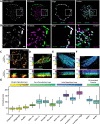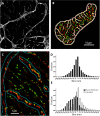Combining multiple fluorescence imaging techniques in biology: when one microscope is not enough
- PMID: 35549314
- PMCID: PMC9265156
- DOI: 10.1091/mbc.E21-10-0506
Combining multiple fluorescence imaging techniques in biology: when one microscope is not enough
Abstract
While fluorescence microscopy has proven to be an exceedingly useful tool in bioscience, it is difficult to offer simultaneous high resolution, fast speed, large volume, and good biocompatibility in a single imaging technique. Thus, when determining the image data required to quantitatively test a complex biological hypothesis, it often becomes evident that multiple imaging techniques are necessary. Recent years have seen an explosion in development of novel fluorescence microscopy techniques, each of which features a unique suite of capabilities. In this Technical Perspective, we highlight recent studies to illustrate the benefits, and often the necessity, of combining multiple fluorescence microscopy modalities. We provide guidance in choosing optimal technique combinations to effectively address a biological question. Ultimately, we aim to promote a more well-rounded approach in designing fluorescence microscopy experiments, leading to more robust quantitative insight.
Figures








Similar articles
-
Recent advances in super-resolution fluorescence imaging and its applications in biology.J Genet Genomics. 2013 Dec 20;40(12):583-95. doi: 10.1016/j.jgg.2013.11.003. Epub 2013 Nov 23. J Genet Genomics. 2013. PMID: 24377865 Review.
-
Applications of imaging fluorescence correlation spectroscopy.Curr Opin Chem Biol. 2014 Jun;20:29-35. doi: 10.1016/j.cbpa.2014.04.006. Epub 2014 May 8. Curr Opin Chem Biol. 2014. PMID: 24814153 Review.
-
[Comparison and progress review of various super-resolution fluorescence imaging techniques].Se Pu. 2021 Oct;39(10):1055-1064. doi: 10.3724/SP.J.1123.2021.06015. Se Pu. 2021. PMID: 34505427 Free PMC article. Review. Chinese.
-
Hypothesis-driven quantitative fluorescence microscopy - the importance of reverse-thinking in experimental design.J Cell Sci. 2020 Nov 5;133(21):jcs250027. doi: 10.1242/jcs.250027. J Cell Sci. 2020. PMID: 33154172 Review.
-
Practical considerations for quantitative light sheet fluorescence microscopy.Nat Methods. 2022 Dec;19(12):1538-1549. doi: 10.1038/s41592-022-01632-x. Epub 2022 Oct 20. Nat Methods. 2022. PMID: 36266466 Review.
Cited by
-
Imagining the future of optical microscopy: everything, everywhere, all at once.Commun Biol. 2023 Oct 28;6(1):1096. doi: 10.1038/s42003-023-05468-9. Commun Biol. 2023. PMID: 37898673 Free PMC article. Review.
-
Multiscale fluorescence imaging of living samples.Histochem Cell Biol. 2022 Oct;158(4):301-323. doi: 10.1007/s00418-022-02147-4. Epub 2022 Aug 29. Histochem Cell Biol. 2022. PMID: 36036808 Free PMC article. Review.
-
Seeing the unseen: The role of bioimaging techniques for the diagnostic interventions in intervertebral disc degeneration.Bone Rep. 2024 Jun 27;22:101784. doi: 10.1016/j.bonr.2024.101784. eCollection 2024 Sep. Bone Rep. 2024. PMID: 39040156 Free PMC article. Review.
References
-
- Amos B (2000). Lessons from the history of light microscopy. Nat Cell Biol 2, E151–E152. - PubMed
-
- Arganda-Carreras I, Kaynig V, Rueden C, Eliceiri KW, Schindelin J, Cardona A, Sebastian Seung H (2017). Trainable Weka Segmentation: a machine learning tool for microscopy pixel classification. Bioinformatics 33, 2424–2426. - PubMed
-
- Baddeley D, Bewersdorf J (2018). Biological insight from super-resolution microscopy: What we can learn from localization-based images. Annu Rev Biochem 87, 965–989. - PubMed
Publication types
MeSH terms
Grants and funding
LinkOut - more resources
Full Text Sources

